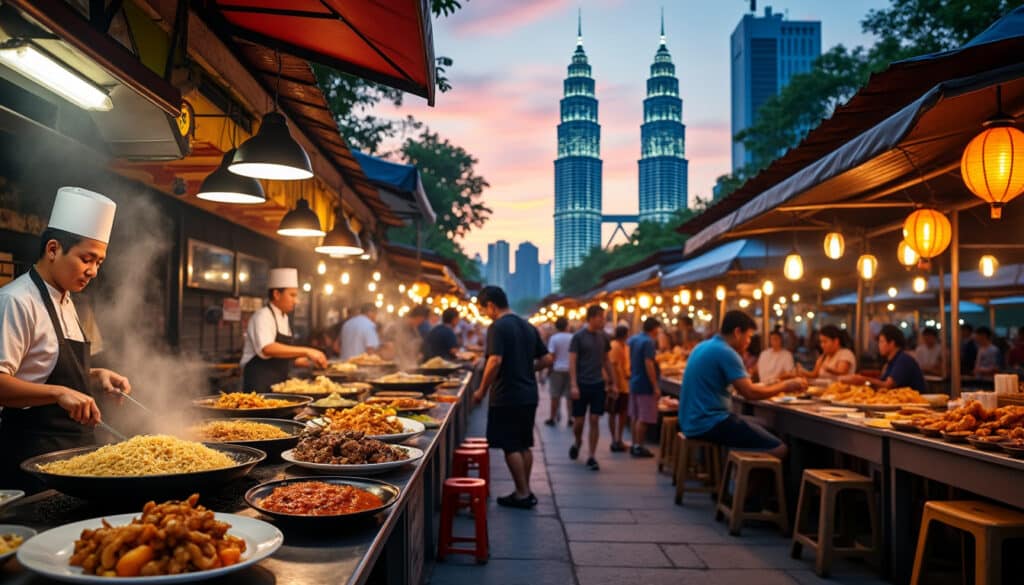The rich cultural tapestry of Kuala Lumpur reflects a unique confluence of histories, traditions, and contemporary vibrancy. As Malaysia’s bustling capital and economic heart, the city offers visitors an enticing mix of old-world charm and modern living. From the iconic Petronas Twin Towers to the bustling markets of Chinatown, Kuala Lumpur presents an extraordinary experience where diverse ethnic traditions harmoniously coexist and continue to influence daily life.
A Cultural Melting Pot: Ethnicities and Traditions in Kuala Lumpur
Kuala Lumpur thrives as a cultural melting pot, with its population predominantly comprising Malays, Chinese, and Indians. These communities shape the city’s cultural landscape through their diverse traditions, festivals, and culinary practices. The Malay community, practicing Islam, is renowned for its craft in woodwork and traditional textile weaving, deeply rooted in regions such as Kelantan and Terengganu. Their religious and festive events like Hari Raya Aidilfitri bring the city to life, with vivid celebrations evident across local neighborhoods.
Chinese Malaysians have significantly contributed to the development of Kuala Lumpur’s vibrant economy and social fabric. Early migrants came to Malaysia for tin mining and now predominantly reside in urban areas, adapting to commercial environments while celebrating their heritage. The Chinese community is renowned for its colorful festivals such as the Lunar New Year, marked by lion dances and bright lanterns along Petaling Street in Chinatown. Mandarin, Cantonese, and Hokkien dialects echo through the bustling streets, offering visitors a taste of Chinese culture.
For the Indian community, hailing mainly from the southern regions of India, Hinduism plays a pivotal role in daily life. Temples are scattered throughout the city, serving as epicenters for festivals like Deepavali. The presence of Punjabi communities introduces vibrant cultural expressions through events such as Vaisakhi, highlighting the diverse spectrum of cultural celebrations in Kuala Lumpur.
Kuala Lumpur’s beauty also lies in embracing the presence of the Orang Asli, the indigenous people who have resided in the region for thousands of years. While modernization influences their lifestyles, preserving their traditional knowledge and skills remains crucial. These groups continue to rely heavily on forest resources, and their unique cultural practices remain a significant yet endangered part of Malaysia’s heritage.
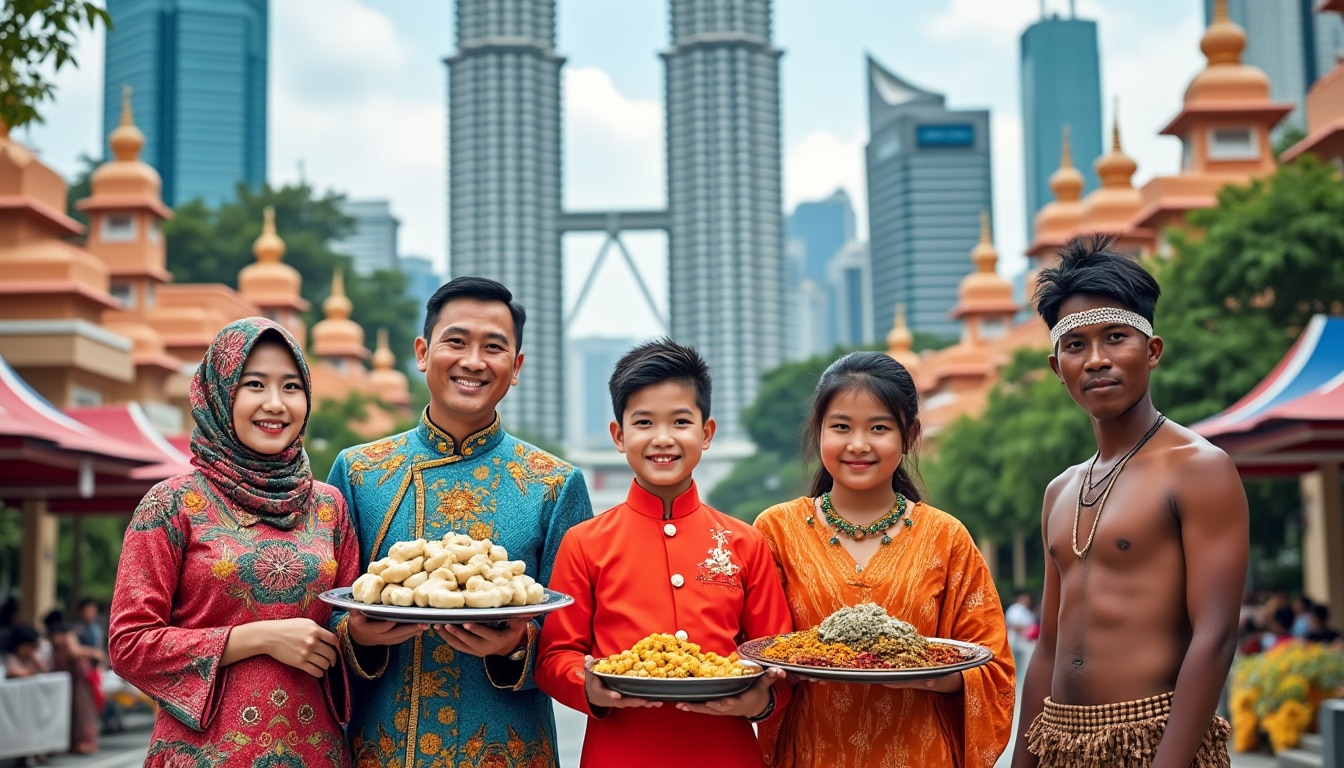
The Blend of Modernity and Tradition in Everyday Life
In the fast-paced urban life of Kuala Lumpur, modernity and tradition coalesce seamlessly. Strolling through areas like KLCC and Bukit Bintang, one encounters skyscrapers and luxurious venues juxtaposed with traditional markets and eateries, offering a sensory overload of flavors, sights, and sounds. The city confidently displays its modern infrastructure while cherishing its historical roots, demonstrated in attractions like Merdeka Square and the Kuala Lumpur City Gallery.
Public transport and daily communication reflect the integration of diverse languages, with many residents speaking English alongside Malay, Chinese dialects, and Tamil, accommodating both locals and visitors. This linguistic diversity eases navigation and fosters inclusivity across different communities. However, pedestrian navigation can be challenging, reminding visitors to adopt local practices in traversing the city’s bustling streets and public spaces.
- 🌟 Malay: Dominant ethnic group, Islam as main religion, rich traditional crafts
- 🌟 Chinese: Major urban population, integral to economic sector, cultural festivals celebrated in Chinatown
- 🌟 Indians: Southern Indian roots, Hinduism as a core part of life, colorful temple festivals
- 🌟 Orang Asli: Indigenous communities, traditional practices facing modernization challenges
Insight into Daily Life and Adaptation
Despite Kuala Lumpur’s status as a vibrant city, adapting to local life involves practical considerations. The availability of apps such as WhatsApp and Grab revolutionizes how people communicate and commute, making modern city life more accessible. These essential tools show how traditional hospitality merges with technological convenience, helping locals and visitors feel at home in this vibrant city.
Exploring Kuala Lumpur’s Culinary Delights
The diverse culinary landscape in Kuala Lumpur reflects the city’s multicultural makeup. From street food adventures to high-end dining experiences, the fusion of flavors from Malay, Chinese, and Indian cuisines offers a tantalizing journey for taste buds. Nasi lemak, Malaysia’s national dish, exemplifies this harmony by combining coconut rice with spicy sambal, crispy anchovies, and aromatic herbs. Such dishes captivate visitors and illustrate the city’s distinctive culinary traditions.
Chinatown Kuala Lumpur’s streets promise a culinary exploration unlike any other. Here, traditional hawker-style options offer authentic local fare like char kway teow and laksa. Nearby Petaling Street is famous for its energetic night markets, brimming with food stalls selling roasted duck and dim sum. Similarly, Jalan Alor is a mecca for food enthusiasts, renowned for its bustling street scene teeming with delicious options that suit diverse palates.
Regional Indian flavors further enrich the city’s vibrant food scene, with Little India in Brickfields offering enticing delicacies such as dosas, masala chai, and curries. The rich array of spices and the authentic preparation methods amplify the sensory experience, transporting diners to the heart of India.
Culinary Adventures and Experiences
To truly savor Kuala Lumpur’s culinary delights, indulge in food tours that navigate the city’s labyrinthine streets and bustling markets. These guided experiences provide insights into local culture, offering the chance to sample everything from quirky modern desserts to time-honored traditional meals. The city also hosts numerous cooking classes, presenting unique opportunities to delve into the intricacies of local cuisine, guided by skilled chefs sharing their culinary heritage.
- 🍽️ Nasi Lemak: A quintessential Malay dish showcasing Malaysia’s flavors
- 🍽️ Char Kway Teow: Stir-fried noodles famous in Chinese cuisine
- 🍽️ Dosas and Curries: South Indian treats abundant in Brickfields
- 🍽️ Laksa: A spicy noodle soup reflecting Southeast Asian culinary art
An Insider’s Guide to Popular Dining Areas
Undoubtedly, Kuala Lumpur’s vibrant dining scene is enriched by its diverse food hubs. Whether in the upscale Bukit Bintang area or exploring eclectic finds in Little India, food enthusiasts are guaranteed to discover flavors that capture the heart and soul of Malaysia’s culinary mastery. Such an array of experiences makes Kuala Lumpur a haven for both the seasoned foodie and the curious traveler.
Vibrant Cultural Events and Artistic Displays
Celebrating cultural diversity in Kuala Lumpur extends beyond everyday life—it finds expression in the city’s vibrant festivals, events, and artistic performances. Year-round, the city hosts numerous celebrations reflecting the diverse ethnic fabric of Malaysia. The Dewan Filharmonik Petronas regales audiences with world-class concerts, with performances ranging from classical symphonies to traditional Malaysian compositions, offering a glimpse into the city’s thriving artistic scene.
Kuala Lumpur’s festivals showcase vibrant dances, music, and art forms, each offering insight into its communities’ rich cultural practices. Ethnically themed festivals dominate the calendar, with events like Hari Raya Aidilfitri, Chinese New Year, and Deepavali celebrated with grandeur, infusing the city with lively rhythms and vibrant colors.
The Kuala Lumpur City Gallery serves as a hub for art enthusiasts, providing fascinating insights into the city’s history and future through compelling exhibitions and interactive displays. Other landmarks, such as the National Mosque of Malaysia, offer panoramic views, reflecting on the city’s architectural brilliance juxtaposed against religious solemnity. Close by, Merdeka Square stands as a symbol of Malaysian independence, hosting national day celebrations and drawing history enthusiasts eager to engage with the country’s past.
Embracing Tradition through Festivals and Events
The diverse range of festivals celebrated in the city reflects its rich cultural heritage. For instance, at the Batu Caves, the Thaipusam festival captivates visitors with its profound religious significance and vivid rituals. The event draws pilgrims and tourists alike, with processions winding through caves as devotees pay homage to Lord Murugan.
Cultural experiences are further enriched by opportunities to participate in artistic displays—be it through workshops in street photography, traditional dance lessons, or visiting heritage workshops displaying batik art and craftsmanship. Such experiences enrich understanding and appreciation of the city’s vibrant legacy, creating lasting memories for visitors.
- 🎨 Thaipusam Festival: Celebrated at Batu Caves with religious and cultural pageantry
- 🎨 Hari Raya Aidilfitri: Festive atmosphere reflecting Malay traditions
- 🎨 Chinese New Year: Featuring lion dances and fireworks, illuminating Chinatown
- 🎨 International Art Festivities: Showcasing Kuala Lumpur’s dynamic art scene
Cultural Institutions and Their Role in Preservation
Kuala Lumpur’s cultural institutions play an instrumental role in preserving and promoting Malaysia’s heritage. These spaces foster a deeper appreciation of national history and cultural diversity, ensuring that future generations understand and continue to cherish this rich legacy. Through collaborative projects, exhibitions, and educational programs, these institutions breathe life into the city’s cultural consciousness and actively engage the community in celebrating Kuala Lumpur’s vibrant tapestry.
Nature and Recreation: Green Spaces in a Bustling City
Amidst Kuala Lumpur’s dynamic urban landscape, the city’s green spaces offer tranquil escapes from the hustle and bustle of daily life. The KL Bird Park stands out as a haven for bird enthusiasts, providing a glimpse into the region’s diverse avian life through expansive free-flight walk-in enclosures. With an emphasis on conservation and sustainability, the park continuously educates and inspires visitors about Southeast Asia’s rich biodiversity.
The sprawling Perdana Botanical Gardens, nestled in the heart of Kuala Lumpur, covers over 90 hectares of lush greenery, offering visitors an ideal setting for leisurely walks or picnics. As a center of horticultural excellence, the garden showcases Malaysia’s indigenous plant species, playing a critical role in conservation and botanical studies.
Batu Caves, just a short train ride from the city center, offers visitors a glimpse into natural wonders, exploring the limestone formations and vibrant ecosystems within. The caves remain a vital part of Kuala Lumpur’s ecological and cultural landscape, providing spectacular sightseeing opportunities and a respite from the city’s busy avenues.
- 🌿 KL Bird Park: Home to diverse bird species and conservation efforts
- 🌿 Perdana Botanical Gardens: The city’s green lung, emphasizing biodiversity
- 🌿 Batu Caves: A natural wonder providing cultural and ecological insights
- 🌿 Eco-Friendly Initiatives: Ongoing efforts promoting sustainability in the city
Lush environments are balanced by the strategic planning of urban centers, ensuring comprehensive environmental initiatives remain a priority. The city continuously invests in eco-friendly projects, promoting urban greening initiatives that enhance quality of life and demonstrate Kuala Lumpur’s commitment to sustainability.
Urban Parks and Recreational Activities
Kuala Lumpur’s urban parks provide essential recreation for residents and visitors alike. They host numerous activities, including guided walks, cycling tours, and cultural events, facilitating opportunities to connect with nature and local communities. Adventure seekers can explore trails at Bukit Kiara and Bukit Gasing, offering an outdoor haven for hiking and exploration.
Expansive green areas like KLCC Park allow visitors to relax, and the park’s interactive fountains provide visual delight, especially during evening light shows. As a family-friendly destination, these parks invite communities to connect and engage in outdoor activities, imparting a sense of tranquility despite the urban chaos surrounding them.
FAQ: Understanding Culture & Local Life in Kuala Lumpur
| Question | Answer |
|---|---|
| What is the main language spoken in Kuala Lumpur? | The national language is Malay, but English is widely spoken along with Chinese dialects and Tamil. |
| Can visitors easily access public transportation in Kuala Lumpur? | Yes, Kuala Lumpur offers an extensive public transit system including trains, monorails, and buses. |
| What are some popular cultural events in the city? | Major events include Thaipusam at Batu Caves, Chinese New Year, and Hari Raya Aidilfitri celebrations. |
| How does the city accommodate green initiatives? | Kuala Lumpur invests in eco-friendly projects and urban parks, promoting sustainability and biodiversity. |
From vibrant cultural expressions to serene natural sanctuaries, Kuala Lumpur offers an unparalleled experience that reflects its historical legacy and modern aspirations. The city welcomes visitors to explore its diverse communities, savor its cuisines, and engage with its artistic endeavors, forging enduring memories of an exceptional urban journey.
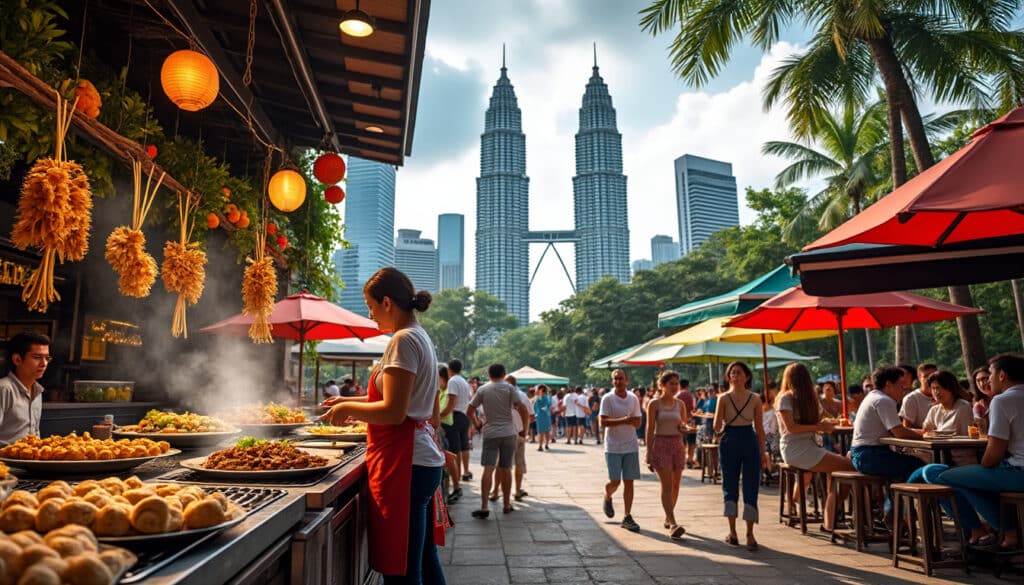
Best places to eat in Kuala Lumpur
Home to a rich tapestry of cultures, Kuala Lumpur is renowned for its culinary landscape that draws inspiration from Malay, Chinese, Indian, and even Western cuisines. This vibrant mix offers food lovers an unparalleled gastronomic experience, from bustling streets serving…

Kuala Lumpur, a bustling metropolis renowned for its culinary diversity, offers a tantalizing array of flavors that reflect its rich cultural tapestry. The city’s food scene is an intricate blend of Malay, Chinese, Indian, and other Southeast Asian influences, making…
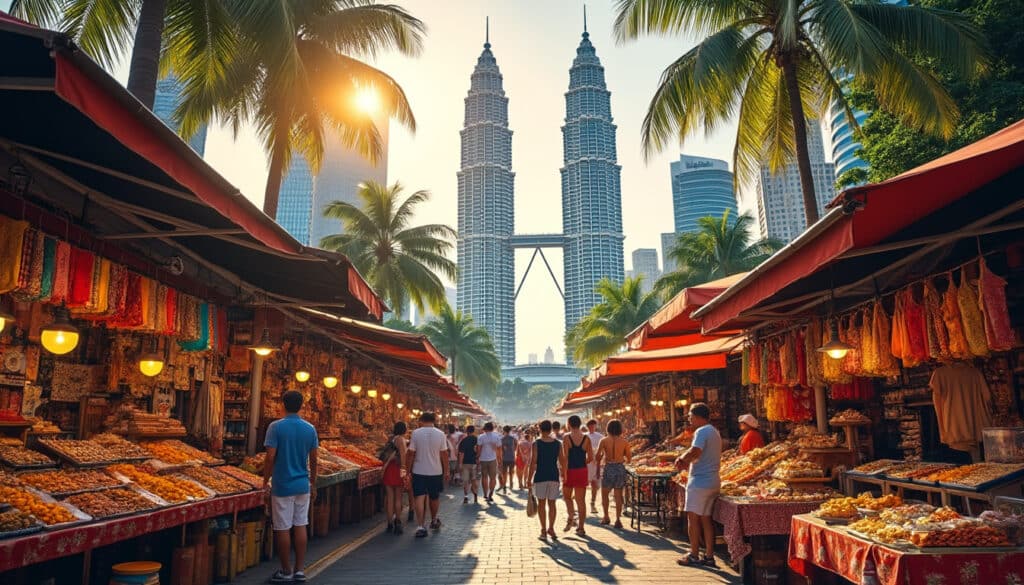
Souvenirs and shopping in Kuala Lumpur
Imagine stepping into the vibrant and bustling capital of Malaysia, Kuala Lumpur, a city renowned for its diverse cultural heritage and modern marvels. As you explore the streets, you find yourself surrounded by an enticing array of shops offering everything…
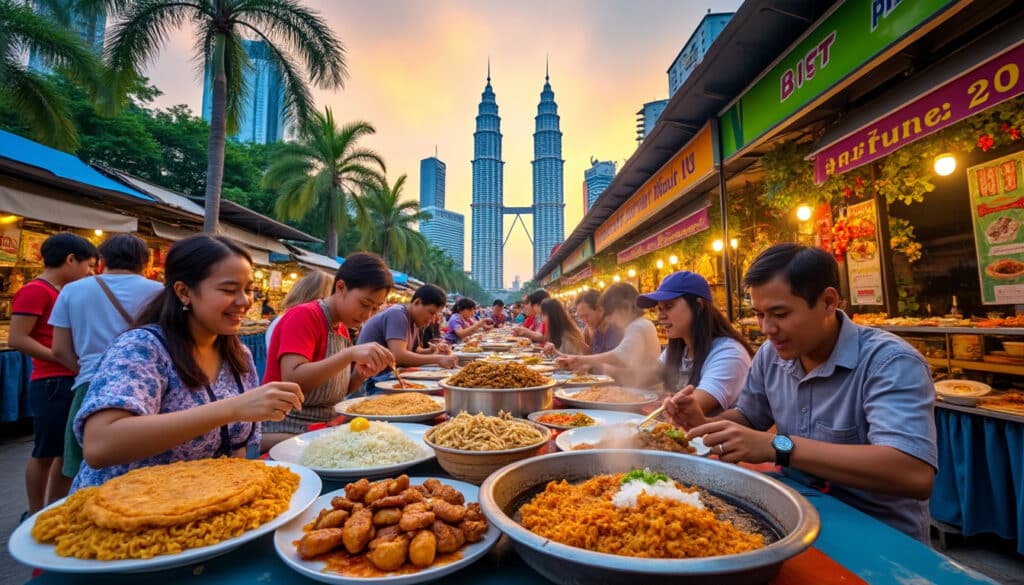
What do people eat in Kuala Lumpur?
Discovering the food landscape of Kuala Lumpur is akin to embarking on a tantalizing culinary journey where every corner reveals a new flavor, texture, and aroma. This vibrant city, a cultural melting pot with Malay, Chinese, Indian, and various other…

Languages spoken in Kuala Lumpur
Kuala Lumpur is a bustling metropolis that offers more than just skyscrapers and sumptuous street food. It is a city where languages tell the story of its vibrant, multicultural tapestry. As you walk through the city’s neighborhoods, each with its…


